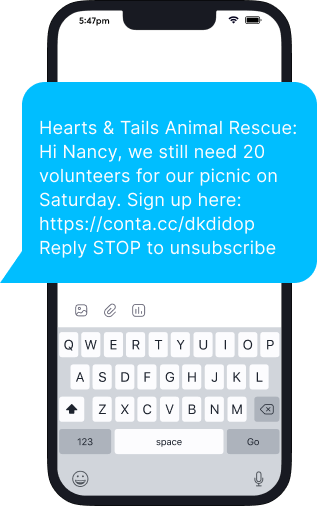
You need to get people excited about the good your nonprofit organization does for the community. SMS for nonprofits can help you do just that.
With nonprofit text messaging, you can instantly alert your donors and volunteers about new initiatives and activities that your organization has planned.
This keeps your nonprofit relevant and at the forefront of the minds of everyone who signs up to receive your messages. From coordinating volunteers and soliciting donations to throwing successful events, SMS marketing for nonprofits all boils down to how you get your message across.
Text marketing for nonprofits
SMS is an acronym that stands for “short message service” and is synonymous with text messaging.
Text marketing for nonprofits capitalizes on the high open rates and speediness associated with SMS to benefit the organization’s marketing efforts.
Can nonprofits send text messages?
Nonprofits can send text messages, and it’s much easier for them to do so than it is for other businesses. Like any business, a nonprofit needs to receive consent from recipients before marketing messages can be sent. Unlike a business, nonprofits can receive oral consent to send SMS messages.
Receiving oral consent to engage in nonprofit text messaging makes it easier to get people to sign up for SMS notifications at community events, when they visit your organization in person, or even when they call with questions.
NOTE: While the FCC allows nonprofit organizations to obtain oral consent before sending any text messages to a contact, professional SMS service platforms require written permission via electronic opt-in form completion. By ensuring that everyone who receives communications through their platform has requested to receive an SMS message, they help everyone to stay in compliance with the FCC and that no account is adversely affected by another’s actions.
Why should you consider SMS for nonprofits?
The biggest reason to use SMS for nonprofits is that this method has proven itself to be more effective than other forms of marketing. In fact, SMS marketing has a response rate that is 209% higher than email, phone, or social media marketing.
Around 98% of text messages are opened within the first three minutes. These fast open rates make text marketing for nonprofits a smart choice for time-sensitive reminders, questions, and marketing endeavors.
How to use SMS for nonprofits
Using SMS for nonprofits is all about reminding your community about your organization and keeping your initiatives at the forefront.
Increase event success
One key way to use SMS for nonprofits is to reach out to community members and remind them about upcoming events. Letting everyone know about your event ahead of time and reminding them to add it to their calendars can improve turn-out rates.
Make it easy for community members to say “yes” to your event by putting the time and date directly in your text message. If there are tickets, you can even include a link so that recipients can buy their tickets using their phones as soon as they receive the text.
You can also use SMS for nonprofits to communicate last-minute information. This might include locale changes, information about inclement weather, or confirmation about new speakers. By being able to send a text message communicating these last-minute details, you keep everyone on the same page and reduce misinformation.
Finally, SMS can increase event success by providing follow-up information, including event donation totals, individual contribution totals, and quick thank yous. Be sure to follow up text message thank yous with longer email thank yous to ensure your donors feel properly acknowledged and appreciated.
Communicate with volunteers
One of the biggest challenges of running a nonprofit is knowing how to recruit and manage volunteers effectively. Using SMS for nonprofits can boost volunteer engagement. You can quickly and easily reach out to volunteers to confirm their schedules, find replacements if someone can’t make it, and recruit new ones from your community.

Text messaging can also be used to send out emergency communications to volunteers and staff. This could include:
- Information about emergency office closures due to weather
- Requests for additional workers or volunteers if someone called out
- Reminders about upcoming events
- Supply updates that everyone needs to know
Aside from sending alerts via text, it’s a good practice to ensure that all of your volunteers and staff members have your phone number. It’s much easier for volunteers to call out in a timely manner — and for you to find the replacement work you need — if your number is already programmed into their cell phones.
Request donations or send pledge reminders
Whether you’re doing your quarterly pledge requests or you’re raising money for a specific event, SMS marketing allows you to reach out to potential donors in your community to request funds.
One great way to do this is by starting a timed campaign. Timed campaigns work great for meeting specific donation goals. You explain what you need funds for and when your goal is for pulling those funds together.
Communities are often proud to work together if it’s in service of a common goal. If you’re trying to purchase a new item or service for your organization, be open about the costs of that service and ask your community to raise funds for that item in particular. This can help get community members excited, especially if they understand the need for the item or service.
You can even pair SMS messages with email marketing to increase the effectiveness of both strategies.
For example, you might start a donation campaign via email. Then you might follow up by using text messages to remind donors of the deadline for donations or to give updates about how close you are to your current fundraising goal.
Confirm donations or pledges
Once you’ve received a donation or a pledge, SMS marketing allows you to send a quick message to the donor to confirm that you’ve received their donation.
Donation and pledge confirmations serve to alleviate any fears donors may have that their donations haven’t gone through while also showing immediate gratitude for their contribution. These can be paired with more formal thank-you letters or emails for maximum community engagement.
Emergency communications
While no one wants them, emergencies still happen. SMS text messages are the perfect way to:
- Reach out to donors for a time-sensitive fundraising campaign
- Send volunteers updates during an emergency situation
- Advise both donors and volunteers of changes in hours of operation or closures
Best practices for using SMS for nonprofits
Using SMS for nonprofits is generally a smart step. However, there are a number of SMS best practices to keep in mind before you begin this journey.
An important best practice involves remaining in compliance with nonprofit texting laws and guidelines. Texting during quiet hours or without oral consent can lead to major fees. Other SMS marketing best practices include:
- Keeping your messages short, sweet, and easily scannable
- Always letting recipients know how to opt-out of receiving future messages
- Providing a clear call to action
- Engaging readers with relevant links (to your donation page or contact information)
Keep your tone in mind as well. Depending on your organization, it may be OK to use occasional emojis or casual terms. But it’s important to maintain professionalism, even if you pride yourself on a down-to-earth business model.

Remember that the goal of SMS messaging is to connect. If the people you’re texting are worried about their privacy or are mentally correcting typos in the messages that you send, connecting with them becomes much more difficult.
How to get started with SMS marketing for nonprofits
The first step to SMS marketing involves signing up with a professional text message marketing provider. An SMS marketing provider can help you send out text messages en masse while still personalizing those texts for individual recipients.
Once you have a text message marketing provider, setting up your nonprofit’s text templates is next. Having text templates at your fingertips makes sending SMS messages quick and easy.
The final step is to build your SMS opt-in list. You can do this by:
- Adding an opt-in option at the footer of your emails
- Reaching out to social media users and asking them to opt-in
- Creating a sign-up form that you use when talking to people in person or at events
- Adding a landing page or sign-up form to your website
- Implementing Text-to-Join
Improve communication with nonprofit text messaging
Donors, paid staff, and volunteers can all benefit from receiving text messages from your organization.
You don’t have to start big — just put together a list of people you already have permission to reach out to via text message and think of ways to grow that list organically in the future. Then, when you’re ready, reach out to text message marketing providers to learn how easy it is to get started with SMS marketing for your nonprofit organization.
If you’re ready to do more with your digital marketing, it’s time you learned how to use SMS and email marketing together.
*This content is not meant to replace legal advice or full regulatory guidelines around text message marketing.




